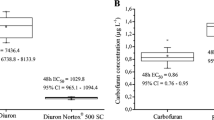Abstract.
Acute and chronic toxicity tests were conducted on the herbicide benzofenap (Taipan® 300) using two Australian freshwater invertebrates. The commercial formulation of benzofenap and a blank formulation containing only the adjuvants of Taipan® 300 were tested against final instar larvae of the midge Chironomus tepperi and adults of the aquatic snail Isidorella newcombi. In 24-h acute bioassays the midge larvae did not show significant mortality at a nominal concentration of 1.2 mg/L active ingredient (AI), double the maximum notional concentration expected in rice fields after application of Taipan® 300 at the permit rate of 2 L/ha. No significant snail mortality was recorded in acute bioassays (24-h exposure, 48-h recovery) at nominal concentrations up to 76 mg/L AI, which is over 120 times the maximum notional field concentration. In chronic assays, the pupation and emergence of C. tepperi was monitored after a 4-h pulse exposure of final instar larvae to Taipan® 300 (nominal concentrations 0.001 to 0.1 mg/L AI) and adjuvant-only (0.1 mg/L equivalent) treatments. No statistically significant effects were observed, although emergence appeared to be delayed by higher benzofenap concentrations and by the adjuvant-only treatment. During snail bioassays, egg and feces production were monitored for 21 days after 24-h exposure to Taipan® 300 (nominal concentrations 1.2 mg/L to 60 mg/L AI) and adjuvant-only treatments (60 mg/L equivalent). No significant chronic effects were proven against I. newcombi, despite a decline in egg mass production following exposure to all treatments and a reduction in the total numbers of eggs produced at the highest nominal concentrations tested (60 mg/L AI and adjuvant-only treatments). Similarly, feces production by snail pairs exposed to the majority of treatments declined, but these differences were not statistically significant. It is concluded that Taipan® 300 does not represent a significant risk to mature C. tepperi larvae or adult I. newcombi in downstream environments when applied to rice fields at the permit rate of 2 L/ha.
Similar content being viewed by others
Author information
Authors and Affiliations
Additional information
Received: 22 September 1998/Accepted: 21 March 1999
Rights and permissions
About this article
Cite this article
Wilson, A., Stevens, M. & Watts, R. Acute and Chronic Toxicity of the Herbicide Benzofenap (Taipan 300) to Chironomus tepperi Skuse (Diptera: Chironomidae) and Isidorella newcombi (Adams and Angas) (Gastropoda: Planorbidae). Arch. Environ. Contam. Toxicol. 38, 176–181 (2000). https://doi.org/10.1007/s002449910023
Issue Date:
DOI: https://doi.org/10.1007/s002449910023




